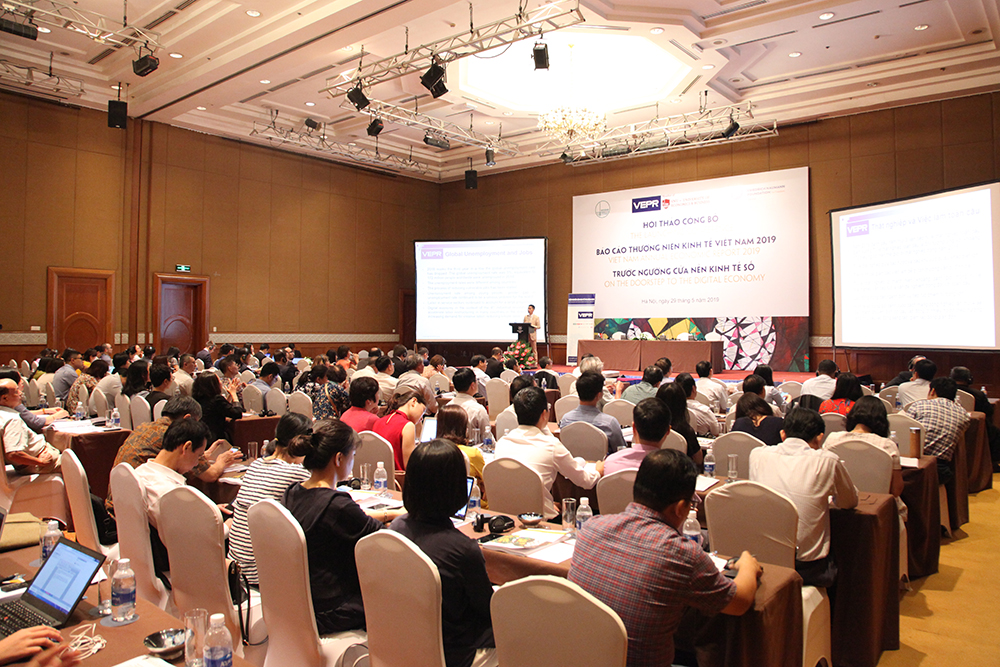On 29th May 2019, VNU University of Economics and Business and the Friedrich Naumann Foundation (FNF) Viet Nam co-organized the Launching Conference of Viet Nam Annual Economic Report 2019 at the Sheraton Hotel, Ha Noi.
Attending the conference, there were Mr. Le Bo Linh - Deputy Secretary of National Assembly, Deputy in chief - Office of National Assembly; scholars and economists, leaders at government agencies, representatives of businesses, corporations. From UEB, there were Assoc.Prof.Dr. Nguyen Truc Le - Rector, Assoc.Prof.Dr. Nguyen Duc Thanh - Director of VEPR together with heads of offices and departments, lecturers and researchers of the university.
Giving the opening remarks at the conference, Assoc.Prof.Dr. Nguyen Truc Le said, Viet Nam Annual Economic Report 2019 is a proud product of VNU University of Economics and Business conducted by the VEPR. Over the past 11 years, the reports were highly appreciated by experts and managers. This year, the report entitled “On the doorstep to the Digital Economy” was conducted with great efforts from the authors and tremendous support from the consultants. On behalf of the UEB, I would like to express my appreciation for the authors and our partners who accompanying the program over the past 11 years.
Assoc.Prof.Dr. Nguyen Truc Le gives the opening speech at the conference
Following the success of prior reports, Viet Nam Annual Economics Report 2019, entitled “On the Doorstep to the Digital Economy”, will set gravity on the development of Viet Nam’s digital economy in the foreseeable future. Indeed, the trend of digitalizing socio-economy activities formed a solid foundation for the emerging of the fourth industrial revolution and promoted its prevalence vertically in developed countries. This has created new challenges due to its “creative destruction” of the traditional markets and current sectorial structure, transforming the whole production system along with the global governance. Under these circumstances, Viet Nam, although has been increasingly integrating into the global production chains, is not likely to catch up with this swiftly transformation. Hence, this year’s report, not only considers and evaluates the world and Vietnamese economies, but also attempts to shed light on the opportunities as well as obstacles to further develop the digital economy under the context of Viet Nam.

After the opening speech, Assoc.Prof.Dr. Nguyen Duc Thanh, on behalf of the authors, presented the Viet Nam Annual Economics Report 2019. He highlighted the two forecast scenarios for Vietnam's economy in 2019. The first scenario predicts the economic growth of 6.56% and inflation rate of 4.21%. The second, which is more likely, produces a result of 6.81% and 4.79% respectively.
Participants give question to the author of the report
In the long-term policy vision, the authors affirm the prerequisite role of the legal system (with the leading role of intellectual property law) and education reform (with the central role of eliminating the monopoly in syllabus and textbooks) for Vietnam in the future.
The Report is composed by six chapters and two appendices.
Chapter 1, “Overview of the World Economy in 2018”, provides an overview of the world economy in 2018.
Chapter 2, “Overview of the Vietnamese Economy in 2018”, provides a general view and assessment on the Vietnamese economy in 2018. Despite of the volatility of the world economy, Viet Nam could successfully meet socio-economic indicators proposed by the congress for the year of 2018. Trading and investment activities had a high growth rate.
Chapter 3, “Viet Nam’s future digital economy”, highlights the mega-trends of development of the Viet Nam’s digital economy and introducing the four scenarios of Viet Nam in 2045 projection.
Chapter 4, “Vietnam’s participation into the global value chain in the context of the 4th industrial revolution”, elaborates facets regarded as fundamental risks that threaten the Viet Nam’s sustainable development strategy supported by export, namely: (i) the inherent bottleneck of the growth model led by export; (ii) the participation of Viet Nam in the global value chain.
Chapter 5, “Application of big data in macroeconomic statistics: using online data for inflation nowcasting”, provides insight about the potential of utilizing web-scraping data to compile price
indexes.
Chapter 6, and the last, “Vietnam’s economic prospects in 2019 and policy implications” evaluates the scale and level of macroeconomic risks in 2019 based on fundamental analyses of the global economy as well as the domestic market. One of the most prominent aspect in 2019 is the acceleration of service trading and e-commerce as a result of the fourth industrial revolution.
Mr. Le Bo Linh discusses with the authors
Assoc.Prof.Dr. Nguyen Viet Khoi answers the question from participant
The information included in the report was updated until December 2018, several was updated until the first quarter of 2019.
The Vietnamese version of the Report is expected to be published in September, 2019, while the English version is expected to be published in December, 2019.
>>> Click
here to see the news in Vietnamese.